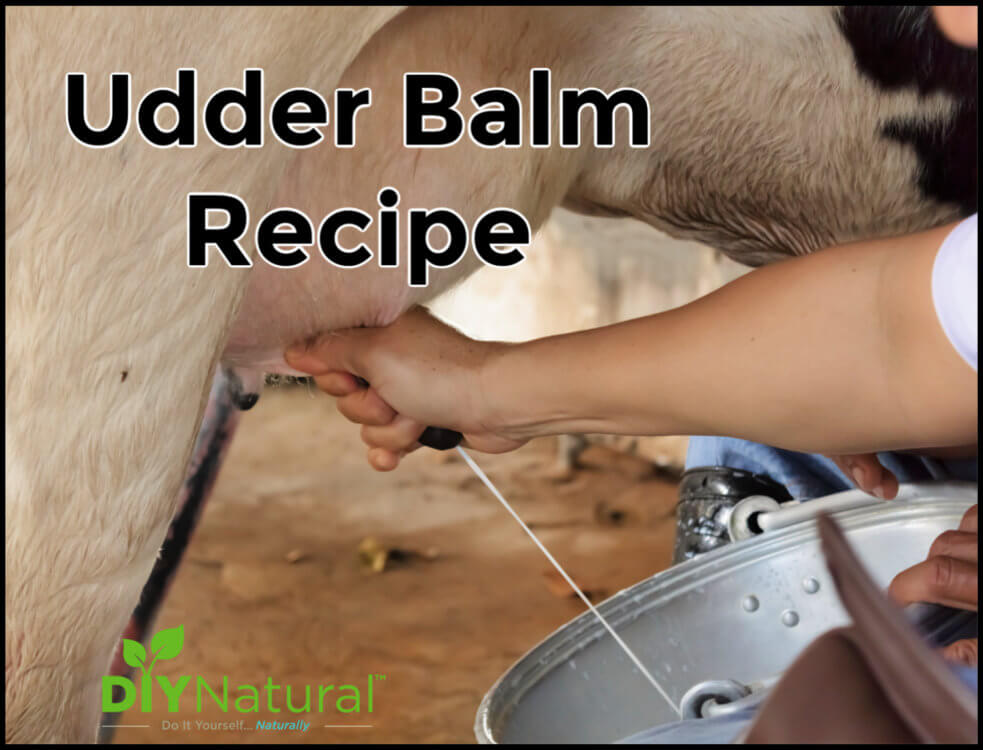

This DIY udder balm is based on a closely guarded recipe from my Uncle Roy in Minnesota. It works well on cow and goat udders but also works great on hands!
I was raised on a dairy farm in East-Central Minnesota. And although I was very young, I remember Uncle Roy washing the cows’ udders down before milking them and using Udder Balm™ or Bag Balm™ after he was done. And he always had nice smooth hands, even after milking over 100 cows. How did he do it? The secret is in the balm!
Udder Balm Ingredients
Although Uncle Roy’s actual balm recipe is a closely guarded secret, this recipe seems exact. I’ve used it on my own goats and it prevents chapped and dried-out skin. It also works great on my hands!
Coconut Oil
Coconut oil is the base, along with olive oil. Both are skin nourishing oils with emollients to help keep the skin in good condition. Coconut oil has the added benefit of being antibacterial and antimicrobial, giving the cows and goats (and you!) a little extra protection when scrapes and minor cuts happen.
Beeswax
Beeswax adds firmness and holding power to this udder balm. Without beeswax, the balm would just be oil and would wear off quickly. Beeswax gives it “holding” power.
Honey
Raw honey adds a bit more antibacterial action. And when combined with skin, especially abraded skin, honey will form a substance similar to hydrogen peroxide, flushing out any bacteria or toxins.
Lavender
The lavender essential oil has calming properties and is antibacterial as well. That, along with rosemary or frankincense essential oils, gives an added layer against pests. Goats and cows can get ticks, fleas, and lice. Even if they don’t stay on the body, these pests can still bite.
-
To make the udder balm, melt the wax and oils in a double boiler. Once they are all melted, add the honey.
READ RELATED: 10 Acne Patches That’ll Help You Stop Picking at Your Pimples: Mighty Patch, ZitSticka, Rael
-
It will want to clump and solidify due to the honey being cooler than the oils and wax. No worries, just keep stirring and it will blend in quickly. The honey may want to sink to the bottom, and that’s ok. You can work it in as it cools.
-
Take the balm off of the heat and add the essential oils. Mix well.
-
As it starts to cool, it will harden on the edges. Scrape it off the edge of the bowl or pot and keep stirring. When you stir as it cools, it will incorporate the honey into the balm, and not let it stay on the bottom. You can also whisk it to form a lighter feeling whipped butter type consistency.
-
When it is all done, transfer it into a wide mouth jar. This makes it easy to dip your hands into.
Udder Balm Recipe
This DIY udder balm is based on a closely guarded recipe from my Uncle Roy in Minnesota. It works well on cow and goat udders but also works great on hands!
Equipment
- Double boiler
Ingredients
- 1/2 cup coconut oil
- 3/4 cup olive oil
- 3/4 cup beeswax
- 1 Tablespoon raw honey
- 15-20 drops essential oil or essential oil blend
Instructions
- To make the udder balm, melt the wax and oils in a double boiler. Once they are all melted, add the honey.
- It will want to clump and solidify due to the honey being cooler than the oils and wax. No worries, just keep stirring and it will blend in quickly. The honey may want to sink to the bottom, and that’s ok. You can work it in as it cools.
- Take the balm off of the heat and add the essential oils. Mix well.
- As it starts to cool, it will harden on the edges. Scrape it off the edge of the bowl or pot and keep stirring. When you stir as it cools, it will incorporate the honey into the balm, and not let it stay on the bottom. You can also whisk it to form a lighter feeling whipped butter type consistency.
- When it is all done, transfer it into a wide mouth jar. This makes it easy to dip your hands into.
Using the Balm
This balm is simple to use. After milking, wipe the udder down, then use a small amount of udder balm to spread on the udder. Whatever is left on your hands can be worked in to keep them soft and supple. Store in a cool spot. If you’re storing the balm in a warm place, like a barn or shed in the summer, the contents may separate. If that happens, simply melt it and stir or whisk again.
I store mine inside on a dresser or in a closet because storing it in the bathroom or kitchen can too warm and humid.
Making udder balm for your milking cows and goats is easy. And be sure to keep some for yourself!
*******
Source: DIY Natural






